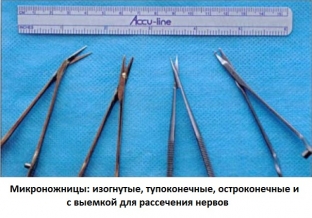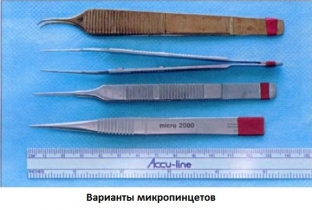Plastic surgery – This is one of the most difficult areas in medicine. The work of doctors of this specialty is often called jewelry, fine, since manipulations with the skin, nerves and blood vessels require high professionalism, extensive knowledge and sufficient experience of the doctor. But no less important for the success of plastic surgery is the correct selection of surgical instruments. Individually selected microsurgical instruments make it possible to achieve the maximum effect from the most complex surgical interventions. estet-portal.com will help you understand the variety of microsurgical scissors, tweezers and other instruments.
Features of the use of various microsurgical instruments
Microsurgery involves surgical interventions under a special microscope, which means that certain requirements are imposed on microsurgical instruments. Their design, shape and size should allow the surgeon to easily manipulate them in a limited surgical field. Microsurgical instruments are predominantly made of titanium or stainless steel and have a matte finish to avoid glare on their surface and ease the burden on the eyes of the operating surgeon. All microsurgical instruments can be divided into several main groups, according to the stages of surgical intervention at which they are used.
Microsurgical Instruments:
- microsurgical instruments required for tissue separation;
- microsurgical instruments required for tissue fixation;
- features of the use of different types of microvascular clamps.
Microsurgical instruments required for tissue separation
Microscissors are widely used among the microsurgical instruments necessary for tissue separation, which provide preparation and separation of the thinnest anatomical formations.
There are four main types of micro scissors:
- microsurgical vascular scissors blunt curved and straight – make it possible to safely dissect the thin surrounding structures and cut relatively dense tissues;
- microvascular pointed curved and straight scissors – in addition to cutting, they allow for the separation of tissues;
- notched scissors – are used to cut the trunks of nerves, allow you to achieve a smooth cut, without damaging the fascicules;
- sawtooth scissors – have denticles that prevent tissue and blood vessels from slipping out.

Microsurgical instruments required for tissue fixation
Hooks and forceps are the most common microsurgical instruments for tissue fixation.
Micro tweezers are used to grip tissue and sutures. There are several types of microsurgical tweezers:
- surgical forceps – have teeth at their ends;
- anatomical tweezers – have transverse micro-notches on the working surface, which is necessary for the preparation of tissues and the isolation of nerves and blood vessels;
- tweezers with smooth working surfaces – necessary for tying microthreads, as they allow them to be firmly held.
One of the mandatory requirements for all types of microtweezers is the exact match of their working ends in a closed state.

Features of using different types of microvascular clamps
There are a huge number of microvascular clamps. Single clips are used to mark vessels and stop bleeding, approximators or double vascular clamps are used when applying vascular anastomoses. All clips are superimposed on the vessels under an operating microscope with great care, since the main disadvantage of their use is the risk of mechanical damage to the intima of the vessels, which as a result can lead to thrombosis in the anastomotic zone. It is important to use microclamps with a minimum force of compression of the jaws corresponding to the caliber of the vessels, which is extremely important to prevent mechanical damage to the walls of the vessels.







Add a comment